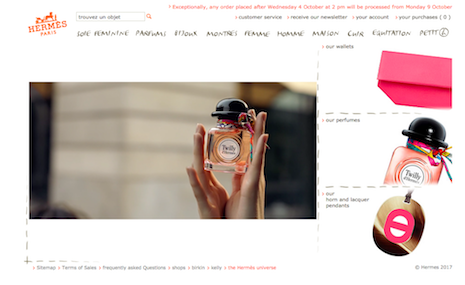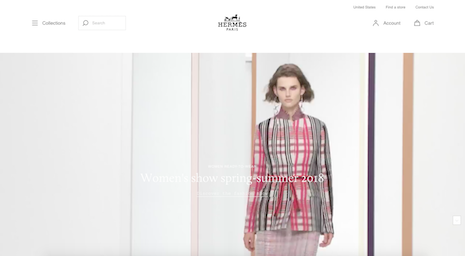
Hermès' new website balances modernity with tradition with the aim to adapt to the digital world by providing a unique online experience for consumers.
French leather goods house Hermès is giving its U.S. online flagship a new look that brings together an editorial perspective and ecommerce.
Hermès’ new Web site was tested in Canada this summer and launched in the United States in October. While holding onto some of the playful personality traits that are hallmarks of its brand, the new digital storefront presents a cleaner, easily navigable browsing experience.
Hermès was reached for comment.
Do you want to know more about enhancing your website's performance to maximise your business?
New look
Hermès’ new site design trades in some of its quirkier style choices, such as a font that mimicked handwriting and illustrations in favor of more imagery and video. The typeface in Hermès’ signature orange has also been exchanged for neutral lettering on a white and grey background.

Screenshot of Hermès' French ecommerce site, which retains its traditional look. Image credit: Hermès
Even with this differing approach, the brand’s positioning and heritage is still reflected in an animated horse silhouette that gallops across the page as it is loading. The label's sense of humor is also reflected in its response to search queries, which says, "Abracadabra! Here are the results..."
Whereas the brand previously maintained a separate microsite, lesailes.hermes.com, to house its content, these features are now integrated into the main Hermes.com. Consumers who navigate to the microsite in the U.S. are redirected to the brand’s central Web site.

Screenshot of Hermès' Web site. Image credit: Hermès
At launch, the new site features nearly full-screen video footage of the brand’s spring/summer 2018 runway show that just took place during Paris Fashion Week. As the user scrolls below the fold, they are invited to explore product categories in Hermès’ “cave of wonders.”
From there, the site showcases pieces of content and collections, from the Apple Watch Hermès to a film featuring the men’s fall/winter collection.
From the menu, most product categories, from equestrian to fashions, includes a link to “stories,” centralizing content for specific audiences. Some product pages also include pieces of content within merchandise listings.
Hermès creates appeal for its silk collection through films, whether showing surfers accessorizing with scarves or giving an understanding of how its scarves are made.
The path from inspiration to purchase is also simplified.
For instance, for Twilly d’Hermès, the brand’s latest scent, the dedicated page on the old site included a video and brief text, requiring consumers to click through and load a separate page to see the products. On the U.S. site, imagery, video and text combine to inspire purchases, and consumers can browse the entire collection from the same page as the content.
While live in parts of North America, the new Hermès Web site has not been rolled out yet to other markets, such as the United Kingdom, France and Japan.
Retail remodel
Similarly to Hermès, Italian fashion house Fendi also gradually rolled out its new ecommerce feature gradually, redesigning its Web site in the process.
The brand has released a new ecommerce feature for its European sites, and the Web site redesign was likely in preparation for this addition. By staying up-to-date on the latest technology, Fendi is ensuring its consumers that it is committed to making their online experience as enjoyable as possible.
Since its founding in 1837, Hermès has had to adapt to changing times, requiring a balance of modernity with tradition, according to the brand’s CEO at the Condé Nast International Luxury Conference April 22.
Helping it remain a presence over the years has been Hermès’ willingness to embrace new methods of communication and adapt its existing craftsmanship when working with what materials are available. As technology evolves, luxury brands must take the lead in a way which maintains their core values and aesthetic.
The Hermès group saw growth across regions in the first half of 2017, boosting its expected profitability to near record highs.
Favorable currency shifts at the period’s close in June had a positive impact on the company’s sales of 35 million euros, or about $41.6 million. Even when measured at constant exchange rates, the group’s sales were up 10 percent for the half year and 8 percent for the quarter, making Hermès optimistic about future growth.
Cover image: Twilly d'Hermès. Image credit: Hermès
Article originally published on Luxury Daily. Republished with permission.

